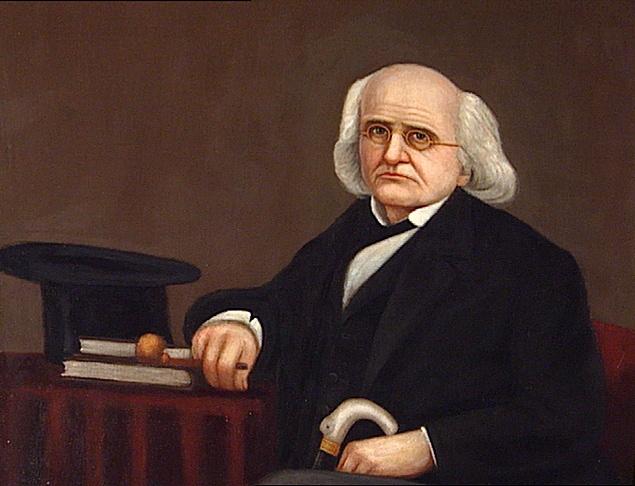
Nashville Architects
William Strickland (1788 – 1854)
Strickland was born in New Jersey and moved with his family to Philadelphia, where at the age of 14 he became an apprentice to the renowned architect Benjamin Latrobe. Strickland opened his own architectural firm and went on to design a large number of Philadelphia's public buildings, including the Merchants' Exchange, the Second Bank of the United States, and the restorations to Independence Hall. He was one of the premier U.S architects when he was commissioned to build Nashville's state capitol building in 1845. Strickland also designed other notable Nashville structures, including James K. Polk's tomb and The Downtown Presbyterian Church. His Greek revival-style design for the state capitol is considered one of his finest works. Strickland died before the state capitol was completed and was entombed, according to his wishes, in the building's northeast corner.
Sources:
Ophelia Paine, "Who's Who in Nashville's History," Nashville Historical Commission, 1996.
Christine Kreyling, Wesley Paine, Charles W. Warterfield, Jr., Susan Ford Wiltshire, Classical Nashville, (Nashville and London: Vanderbilt University Press, 1996), p. 40.

Adolphus Heiman (1809 – 1862)
Adolphus Heiman, born the son of a building superintendent in Prussia, arrived in the United States in 1834. He spent time in New York and New Orleans before coming to Nashville as a stonecutter in 1837. His status changed from craftsman to architect in the late 1840s, after he returned a hero from the Mexican War.
Heiman incorporated several styles, including Gothic revival, Greek revival, and Italianate, into his designs of churches, government buildings, and private homes. He designed many notable buildings in the Nashville area - St. Mary's Catholic Church, the Medical Department at the University of Nashville, and the Belmont Mansion - before he died serving the Confederacy in 1862.
Sources:
James Patrick, Architecture in Tennessee, 1768-1897, (Knoxville: The University of Tennessee Press, 1981), p. 30, 145-151.
Leslie N. Sharp, "Adolphus Heiman," The Tennessee Encyclopedia of History and Culture, Online Edition (Knoxville: The University of Tennessee Press, 2002).
Henry C. Hibbs (1882 – 1949)
Henry Hibbs, a New Jersey native who was educated at the University of Pennsylvania, was working for the New York firm of Ludlow and Peabody when he came to Nashville in 1914 to supervise construction of the George Peabody College campus. When the construction was completed, Hibbs made Nashville his home, opening his architectural office in 1917. He became one of Nashville's most notable architects, designing buildings such as the original Vanderbilt University Library,
Wightman Chapel, and the Nashville Electric Building.
Hibbs was the first president of the Tennessee Chapter of the American Institute of Architects (AIA) and was the author of the first state bill regulating architectural practice in Tennessee, which passed in 1921. In addition, Hibbs was a Fellow of the AIA and received two AIA gold medals in 1929 - one for his work at Scarritt College in Nashville.
Source:
Frank Orr, Elbridge White, Charles W. Warterfield Jr., ed., Notable Nashville Architecture 1930-1980 (Dallas: Taylor Publishing Company, 1989), p. 75.
James A. Hoobler, "Henry Clossen Hibbs," The Tennessee Encyclopedia of History and Culture, Online Edition (Knoxville: The University of Tennessee Press, 2002).
Edwin E. Keeble (1905 – 1979)
Edwin Keeble was born into a distinguished Tennessee family. His father was an attorney and later the dean of the law school at Vanderbilt University and his paternal grandfather was a State Representative from Tennessee during the second Congress held in Richmond, Virginia, 1864-1865. Keeble attended Montgomery Bell Academy and entered Vanderbilt University at the age of sixteen. After receiving his engineering degree from Vanderbilt in 1924, he studied architecture at University of Pennsylvania and in France and Italy. He received his architectural degree from the University of Pennsylvania in 1928, at the age of twenty-three.
Keeble began practicing architecture in Nashville, and in 1929 his association with architect and engineer Francis B. Warfield established the firm of Warfield and Keeble, which existed until 1944. After a two-year term of service as a lieutenant in the United States Navy, Keeble established a private architectural practice in Nashville and designed many notable structures, including Woodmont Christian Church, Immanual Baptist Church, and Vine Street Christian Church.
Source:
Frank Orr, Elbridge White, Charles W. Warterfield Jr., ed., Notable Nashville Architecture 1930-1980 (Dallas: Taylor Publishing Company, 1989), p. 76.
McKissack and McKissack Architects (1905 – )
Moses McKissack III (1879 – 1952)
Calvin Lunsford McKissack (1890 – 1968)
The first Moses McKissack was a slave who learned to be a master builder. He passed his trade on to his son Gabriel Moses, who in turn passed it on to his son, Moses III. Born in Pulaski, Tennessee, Moses III attended the segregated Pulaski public schools and began work for an architect in that city in 1890. By 1895, he was a construction superintendent, building homes in Pulaski, Mt. Pleasant, and Columbia, Tennessee.
In 1905, Moses III built a residence for the dean of architecture and engineering at Vanderbilt University and opened his first office in Nashville. One of his first major design projects was the Carnegie Library on the Fisk University Campus. In 1922, Moses III and his younger brother, Calvin Lunsford McKissack, became partners in the firm of McKissack and McKissack, establishing one of the oldest African American architectural firms in the U.S. The McKissacks were among the first registered architects in the state and went on to build numerous buildings, including the Tennessee State University Memorial Library, Pearl High School, and Capers Memorial CME Church.
Source:
Linda T. Wynn, "McKissack and McKissack Architects," The Tennessee Encyclopedia of History and Culture, Online Edition (Knoxville: The University of Tennessee Press, 2002).
Ophelia Paine, "Who's Who in Nashville's History," Nashville Historical Commission, 1996.
